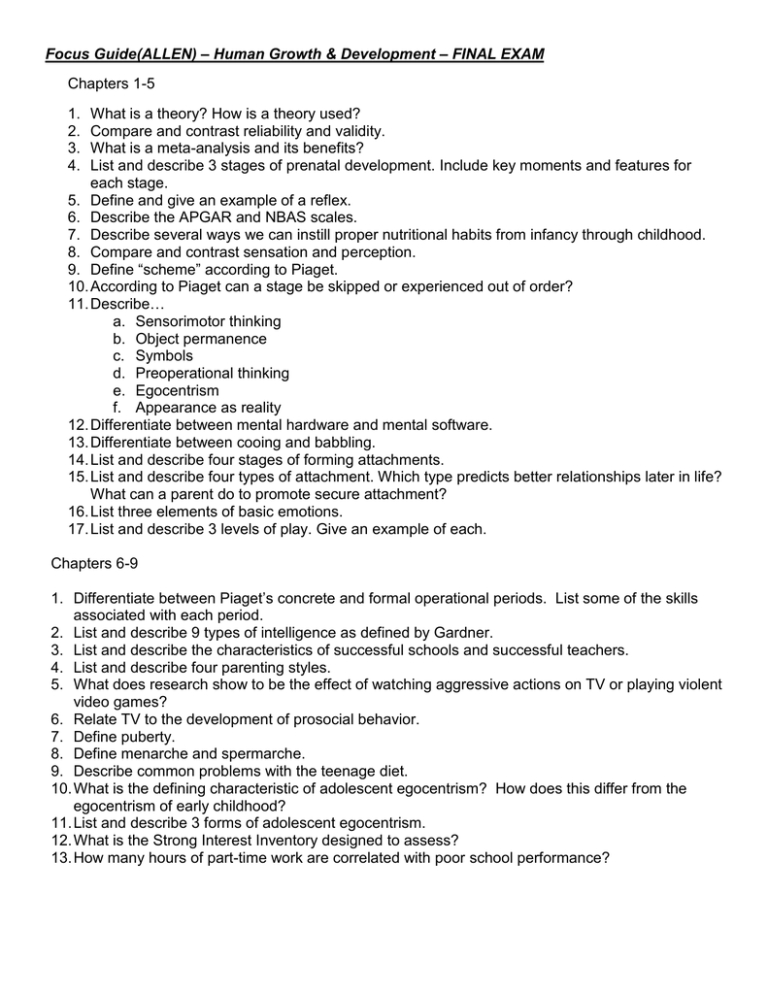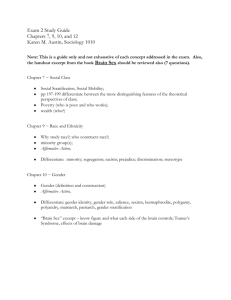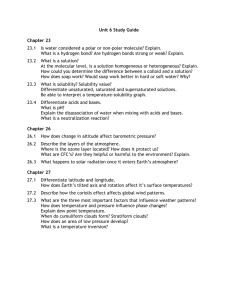Final Focus Guide
advertisement

Focus Guide(ALLEN) – Human Growth & Development – FINAL EXAM Chapters 1-5 1. 2. 3. 4. What is a theory? How is a theory used? Compare and contrast reliability and validity. What is a meta-analysis and its benefits? List and describe 3 stages of prenatal development. Include key moments and features for each stage. 5. Define and give an example of a reflex. 6. Describe the APGAR and NBAS scales. 7. Describe several ways we can instill proper nutritional habits from infancy through childhood. 8. Compare and contrast sensation and perception. 9. Define “scheme” according to Piaget. 10. According to Piaget can a stage be skipped or experienced out of order? 11. Describe… a. Sensorimotor thinking b. Object permanence c. Symbols d. Preoperational thinking e. Egocentrism f. Appearance as reality 12. Differentiate between mental hardware and mental software. 13. Differentiate between cooing and babbling. 14. List and describe four stages of forming attachments. 15. List and describe four types of attachment. Which type predicts better relationships later in life? What can a parent do to promote secure attachment? 16. List three elements of basic emotions. 17. List and describe 3 levels of play. Give an example of each. Chapters 6-9 1. Differentiate between Piaget’s concrete and formal operational periods. List some of the skills associated with each period. 2. List and describe 9 types of intelligence as defined by Gardner. 3. List and describe the characteristics of successful schools and successful teachers. 4. List and describe four parenting styles. 5. What does research show to be the effect of watching aggressive actions on TV or playing violent video games? 6. Relate TV to the development of prosocial behavior. 7. Define puberty. 8. Define menarche and spermarche. 9. Describe common problems with the teenage diet. 10. What is the defining characteristic of adolescent egocentrism? How does this differ from the egocentrism of early childhood? 11. List and describe 3 forms of adolescent egocentrism. 12. What is the Strong Interest Inventory designed to assess? 13. How many hours of part-time work are correlated with poor school performance? Chapters 10-13 1. Define emerging adulthood. 2. Differentiate between fluid and crystalized intelligence. 3. Define the following ideas related to personality development … a. Life-span construct b. Scenario c. Social clock d. Life story e. Possible selves 4. List and describe Sternberg’s three components of love. 5. Differentiate among singlehood, cohabitation, and marriage. 6. List and describe three kinds of cohabitation. 7. Describe the typical pattern of marital satisfaction according to the chart in your notes. 8. According to Holland, what do we look for in a career? 9. Describe key factors of alienation and burnout. 10. What are the characteristics of osteoporosis? 11. What are the characteristics of “the climacteric”? 12. List 3 reproductive changes found in men. 13. Differentiate between a Type A and Type B personality type. 14. According to Erikson what is generativity? Stagnation? 15. Define “kinkeeper” and “sandwich generation”. Chapters 14-16 1. Describe the most common form of dementia, Alzheimer’s disease. 2. Differentiate among average, useful, and maximum life spans. 3. List and describe 4 biological theories of aging. 4. List and describe two types of aids to maintaining memory. Give examples for each type. 5. Describe continuity theory. 6. What age/gender is most likely to be experiencing widowhood? 7. Differentiate between clinical and whole brain death. 8. How is a vegetative state different from death? 9. List several “end-of-life” issues. 10. What do bioethicists study? 11. Differentiate between active and passive euthanasia. 12. Describe a living will and a durable power of attorney. 13. List and describe the Kubler-Ross Stages of dying. 14. Differentiate between bereavement, mourning, and grief.





